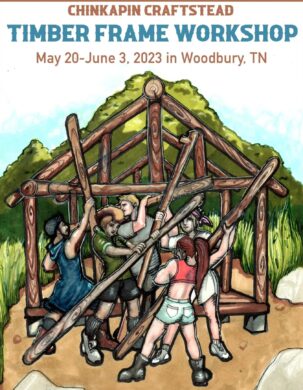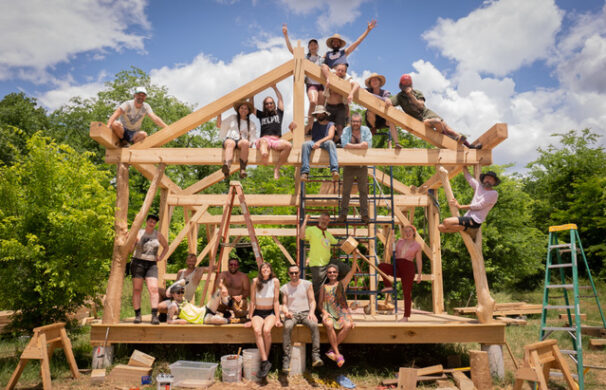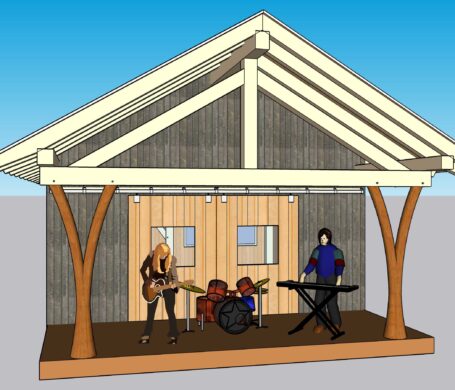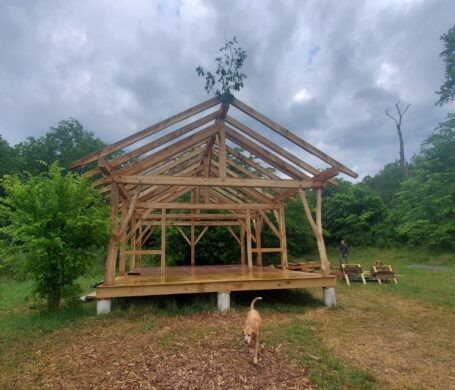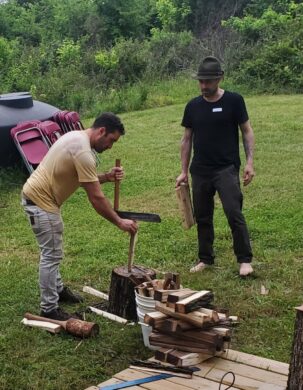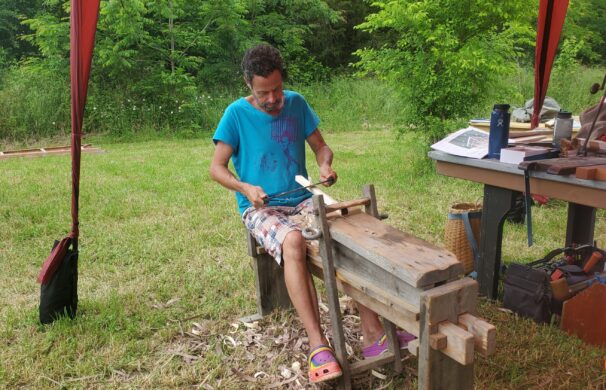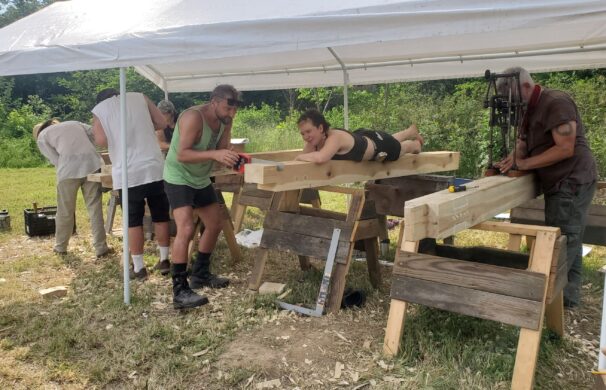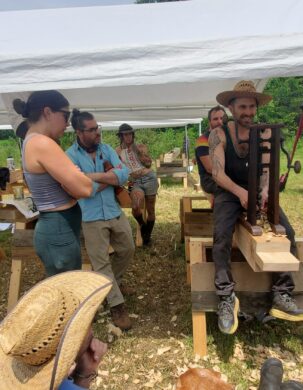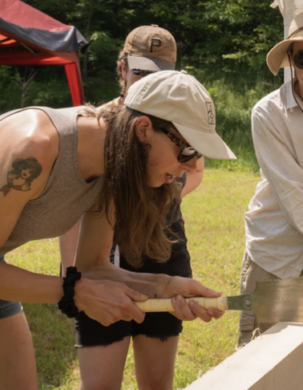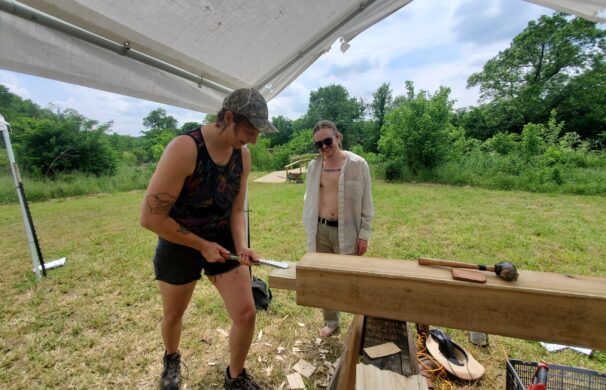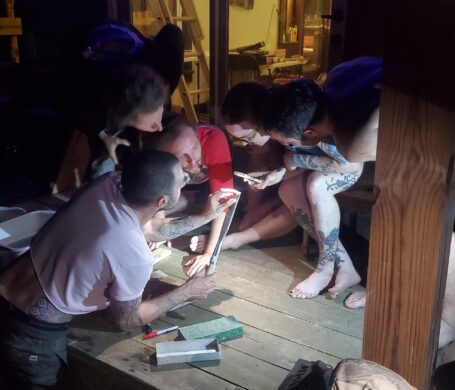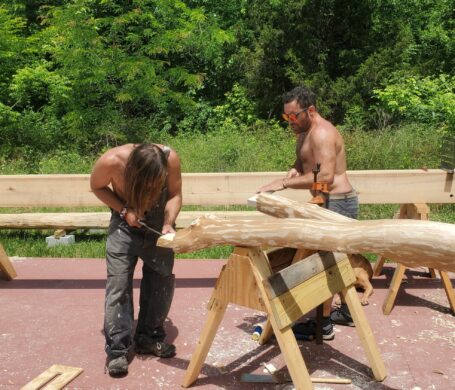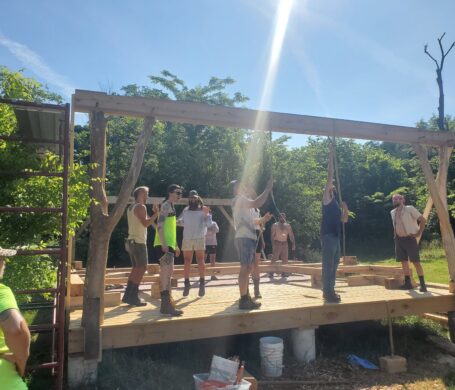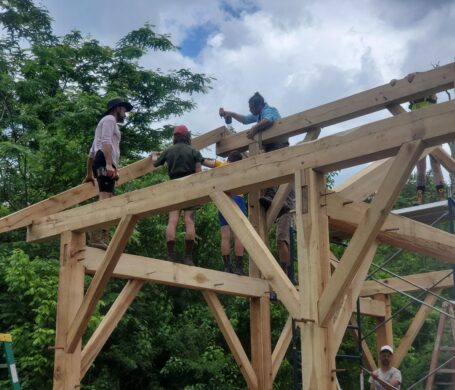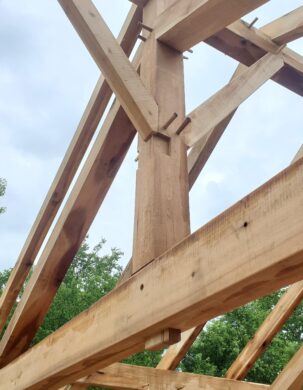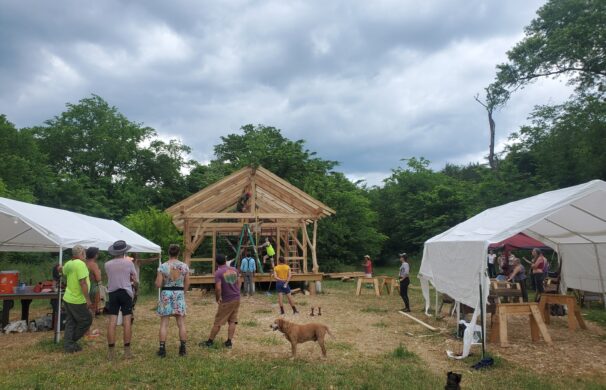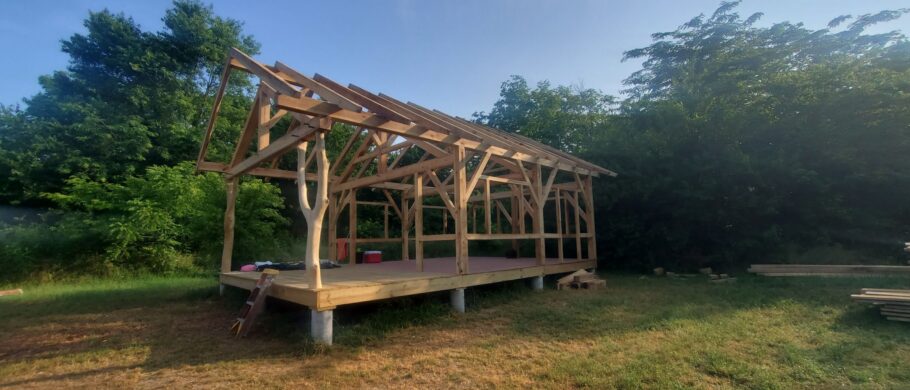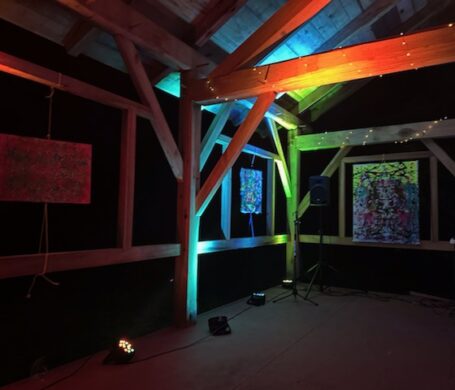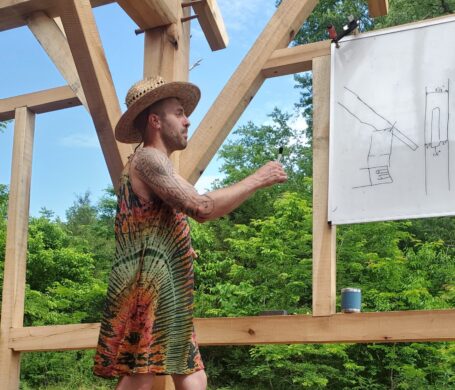It is amazing how time moves and shifts. A couple short weeks can feel like an eternity in another world, and likewise an entire summer can fly by in the blink of an eye. And it is within this ebb and flow that I’ve finally got some time to sit down and share a few thoughts from a trip last May that feels like a lifetime ago, and felt like it’s own lifetime while it was happening…
Between late May and early June of this year, Ariel and I (Dawn) took three weeks away from TimberHomes Vermont to teach a timber framing workshop in rural Tennessee. It’s going to be hard to encapsulate what made this trip so special, but I’m going to try. The overview is this: The two of us packed up a truck full of antique tools, drove down to a queer land project in Tennessee and taught a group of 20 people – mostly queer and trans folks – to hand-cut a timber frame. Then, we raised the frame we cut, and it will be finished by local residents to become a gallery, meeting hub, and performing arts stage for the thriving rural queer community down there.
The project began as a series of conversations by TimberHomes’ own Ariel Schecter and the coordinator at Chinkapin Craftstead, Dashboard. The two worked together over several months to develop the design for the structure we would build, as well as what the workshop might look like. Dashboard presented the concept to the board of directors at Chinkapin, and the project was announced in late winter 2023. At first, there were not too many registrants, but after a plug on social media from well-known fermenter Sandor Katz, the class reached its 20 person capacity, with a small waiting list. Thanks Sandy!
Over the course of the spring, we two timber framers developed the structure of the class and prepared the tools we needed to bring. On May 17th we hit the road and made our way down through Appalachia, arriving at Chinkapin Craftstead a couple days later. Coming from still-thawing northern Vermont, the warm humid air of the Gay South was a welcome change of atmosphere. We set up our worksite, organized tools, made final preparations for the schedule of the class, and took a few moments to relax and celebrate before the participants arrived. The land itself is beautiful; over 200 acres of woodland, some pasture, a spacious cabin, a small spring bath for dunking on hot days, and a 400+ year old Chinkapin Oak tree after which the land is named. How nice it was to have a couple days of calm and rest before the hot, vibrant energy of the workshop.
On Saturday afternoon, the workshop participants started rolling in, and by the evening almost everyone was present. We began with a slideshow presentation of some of TimberHomes’ most inspiring work, a few general notes about timber framing, and an overview of the structure we were about to build. That structure, for those wondering, was a 20’x30′ four-bent king post gable truss building cut entirely in poplar, with the front 10′ working as a stage and the rear 20’x20′ enclosed to create a gallery, backstage, meeting place, or who-knows-what-else. The stage is framed by two live hackberry tree forks which are scribed and mortised into the tie beam they support. Large sliding doors bring the two spaces together, and windows all the way around the building provide ample natural light. It is a simple, soulful, beautiful building.
The first day of the workshop, a lovely spring Sunday morning, we began with basic tool care and use, information on reading plans, and basic cutting. Over the next week, the students learned how to cut a mortise and tenon, the two components of the most common joint in timber frame carpentry. We also gave instruction on cutting braces, rafters, and how to read plans like a pro. At night Ariel gave various demos on topics like tool sharpening and buying the right antique hand tools. That first week was action packed, and the group energy was high and enthusiastic. It was amazing to see this group learn together, and take on a new skill so quickly! People worked in pairs and tackled a timber at a time, checking and teaching each other along the way, and working together to develop skills around tool use and decipher the not-all-that-simple timber framing plans. I remain proud of and astonished by all the people who came to learn this craft.
After the first weekend, we dove into the more complex elements of the timber frame, like cutting scarf joints and scribing tree forks. Bear in mind that we were cutting this whole frame by hand, which meant none of the power drills, circular saws, chain mortisers, or bandsaws that make modern timber framing so efficient. In lieu of those technological conveniences, we employed pull saws, framing chisels, mallets, hand-driven mortise machines, and good old fashioned elbow grease. Many of the tools we used were over a century old. Truth be told, it wasn’t only the students’ first time hand-cutting an entire timber frame… it was also mine! I really gained an appreciation for the modern technology and conveniences that make my work possible in this fast paced world, and also learned how powerful hand tools can be when used with a razor sharp edge and lots of enthusiasm!
On the 9th working day at the workshop, a day ahead of schedule, the frame was cut and it was time to raise! Much like the cutting of the frame itself, the group raised this frame entirely by hand. It was a long day, and by far the most wonderful timber frame raising I have ever been a part of. In addition to a beautiful group of queer and trans folks doing the work, there was also a looovely viewing gallery of people watching the raising, all dressed to the nines and cheering us on in gay splendor as we knocked each timber into place. It was so special to do this work outside of the mainstream culture of the construction world, and in an environment that felt so completely queer. For me personally, it was liberating and rare in the sense that all parts of myself – queer person, trans woman, passionate carpenter, kinda-butch dyke – could all exist totally seamlessly in that environment. So often I think queer people have to meter ourselves in the cis-het dominant world we live in, and similarly, it can be hard to find other queers who love and cherish tradework. But in this place, straddling a ridge beam looking over the rolling hills of Tennessee, beautiful queers all around working together to build something tall and mighty, my heart felt full and the world I long for felt possible.
Over the next couple of days, we put the finishing touches on the frame, cleaned up, and said goodbye to each other. It is wild how close we all became over those two weeks, like the intensity of the workshop allowed a whole world to spring forth where we knew only each other and thought about only one common goal. I think feelings like this can’t last forever by their very nature; there is some magic created in coming together with a common intention, seeing it through, celebrating its completion, and in a way grieving the underlying truth that that completion signals an end. When that frame was finished, I think we all felt the portal to the real world begin to open back up and beckon us gently towards returning to the world outside this magic paradise we had created for a short while. The whetting bush blowing in the wind atop the finished frame seemed to be waving hello and goodbye all at once.
This workshop was meaningful for me personally in a couple ways, and I’ll try to keep it brief as I have already waxed poetic about it plenty in this blog post. The biggest picture I can put on it is that this trip down to the Short Mountain area in Tennessee was a huge full-circle moment for me in terms of queer identity and the search for other people like me. As a closeted teenager, I used to stay up late at night on the family computer, reading about Short Mountain and the radical faeries that live there. It was through that web searching that I first saw pictures of butch trans women, queer people living outside homonormative urban culture, and gay people coming together to tend land and take care of each other. It was way outside what I understood about the world or myself at the time, and it all seemed so far away. But those words and images would guide and ground me through the next decade of understanding my queer identity, a constant star in the night sky to reference as I began to understand myself and the world around me. So, one might imagine how significant it felt to finally visit this near-mythical place, not only as a silent observer, but as someone with skill and knowledge to share. It felt really meaningful to make a small contribution to this community, like a symbolic (and literal) way to say thank you to those faces and voices I’d come across so many years ago, during nights illuminated by the light of the world wide web and so scared of who I knew I was becoming. That fear is a distant memory now, and I have new associations with Short Mountain now that reflect how far I’ve come, what I’ve learned and what I have to teach.
I hope to do more of this kind of thing, whether it be future projects near Short Mountain, workshops for queer/trans folks and other marginalized groups, or trips to teach the wonderful craft of timber framing away from home. This moment can surely never be replicated, but I hope to make room for opportunities like it. Thank you to all the people at Chinkapin Craftstead who made this amazing workshop possible.
If you want to learn more about Chinkapin Craftstead or see more phots and video from the workshop click here and here
